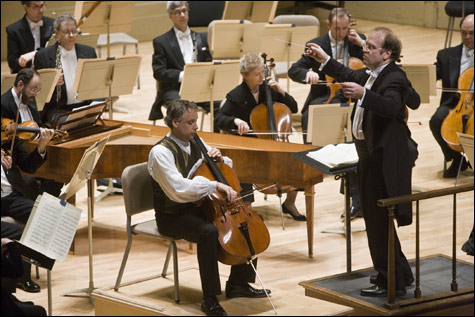
BAROQUE THAT ROCKS? Playing a Haydn cello concerto with the BSO, Pieter Wispelwey dug in like Jimi Hendrix. |
If 2009 lives up to the grace and power of some of the concerts that began it, we can look forward to a vintage year. The good stuff began when New England Conservatory served up a rare evening of Haydn keyboard trios, with the Boston Museum Trio's John Gibbons on fortepiano, young violin master Gabriela Diaz, and cellist Laura Blustein, chair of NEC's string-and-piano-chamber-music division. To judge by the program booklet, you'd have thought these were fortepiano pieces with minimal string accompaniment: Gibbons's name was printed four times larger than his colleagues' (surely an embarrassment to him), and his biography filled half a page, with the rest blank, nothing at all about the other two. And as with most of the program booklets for NEC's free concerts, there wasn't a syllable about the music. These aren't difficult pieces, but they're played so seldom, listeners could have used some context.
The five trios dated from both early and late in Haydn's career. It's a form he practically invented. As with Beethoven, the earlier pieces are formally accomplished and inventive; the later one are more ambitious, profound, and idiosyncratic — occasionally they're even sublime. The heavenly looping Adagio of the 1795 post-Mozart F-sharp-minor is a transcription of the slow movement of the great Symphony No. 102 of the previous year. And the exuberant "Gypsy" Rondo of the G-major made an exhilarating ending.
These were all elegantly played, and Blustein's appearance was generous, since the cello part amounts to accompaniment. In fact, the warmth and color of her rhythms added immeasurable support. Gibbons played with a continuously unfolding, singing line. And Diaz shone in her extended solo passages, finding a balance between bravura display and self-abnegating cooperation.
Two more piano trios were central to the latest in the Gardner Museum's series of "Composer Portraits." The composer was Leon Kirchner, who, on the eve of his 90th birthday, is now living in New York, after a long teaching and conducting career at Harvard. In lieu of program notes, his friend flutist Paula Robison interviewed the reluctant composer. "I thought wisdom came with age, but I was wrong. . . . I shouldn't be forced to do this at this age," he muttered.
The music, however, was ageless. Kirchner is one of America's most mercurial composers: intense, uninhibited, alternating (and combining) ferocity and delicacy, agitation and soulfulness. The marvelous Claremont Trio (twins Emily and Julia Bruskin, violin and cello, and pianist Donna Kwong) gave radiant, thrilling performances of the early Trio No. 1 (1954) and the later Trio No. 2 (1993), both of which are on their latest Tria CD. Robison and gifted young Tokyo-born percussionist Ayano Kataoka nodded to Kirchner's middle period with the atmospheric Flutings for Paula (1973), which was conceived for Lily, Kirchner's opera based on Saul Bellow's Henderson the RainKing. And two other impressive musicians, violinist Corey Cerovsek and pianist Jeremy Denk, provided knockout versions of Kirchner's knotty Duo No. 2 (2001), which he composed in memory of the legendary violinist Felix Galimir, and the early, breathtaking Sonata Concertante (1952). Kirchner said: "Isn't a composer lucky to have such youngsters play his music?"
Dutch cellist Pieter Wispelwey returned to the BSO in an unusual (for the BSO) Baroque/classical program that included ballet music from Mozart's opera Idomeneo, Haydn's Cello Concerto No. 2, and the first complete BSO performance of all three of Handel's Water Music suites. Canadian conductor Bernard Labadie is a Baroque expert who doesn't see a contradiction between 18th-century performance practices and a big orchestral sound or shapely phrasing. In these lively, engaging performances, the BSO gave its best shot at period style. Wispelwey's tone ranged between the refined and the rough-hewn. (A friend compared some of his digging-in to Jimi Hendrix.) John Ferrillo played an eloquent oboe solo and horn players James Sommerville and Jonathan Menkis set off sparks in the famous fanfare in the First Suite. Even more surprising was the enchanting duet in the Third Suite for recorder (Roy Sansom) and theorbo (Chris Henriksen), instruments not often heard with the BSO. The brilliant trumpets of the Second Suite ended the program.
Between the Friday afternoon and the Saturday evening BSO concerts, Sommerville came to the rescue of the Cantata Singers. US Homeland Security Immigration Services didn't process in time the visa for the British horn player engaged for Benjamin Britten's Serenade for Tenor and Horn. So at the last minute Sommerville agreed to play this demanding part, one of the two or three greatest pieces ever written for horn. He gave a spectacular performance. The Serenade begins and ends with a mysterious call on a valveless natural horn; I don't think I'll ever hear it so flawlessly or expressively played. Britten is widely regarded as the 20th-century's best poem setter, and in this masterpiece, he uses short poems that move from sunset to evening and into night, uniting charming 17th-century poet Charles Cotton with sumptuous Tennyson, harrowing Blake ("The Sick Rose"), glittering Ben Jonson, death-haunted Keats, and a bone-chilling 15th-century Scottish dirge. Britten is one of the few composers who can make iambic pentameter not sound mechanical or sing-song. The outstanding young tenor Michael Slattery managed not to imitate Peter Pears, for whom the piece was written; he understands the poems and conveyed not only meaning but nuance. As did conductor David Hoose and his splendid orchestra. A magnificent performance of a very great work.